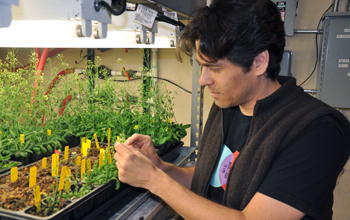Multimedia Gallery
Synthetic chemical offers solution for crops facing drought (Image 1)
Sean Cutler, an assistant professor of plant cell biology in the Department of Botany and Plant Sciences at the University of California, Riverside, examines an Arabidopsis, a small, flowering plant used widely in plant biology labs as a model organism.
Crops and other plants are constantly confronted with adverse environmental conditions. Plants use specialized signals, called stress hormones, to sense difficult times and adapt to stressful conditions to enhance survival. Of the various stress hormones produced by plants, abscisic acid (ABA) has emerged over the last 30 years as the key hormone that helps plants cope with drought conditions.
Research led by Cutler suggests the possibility of spraying stable synthetic chemicals on plants to enhance stress tolerance during drought and improve yield. Cutler identified pyrabactin, a synthetic chemical that turns on the ABA signaling pathway in Arabidopsis, and used it to fish out a receptor for ABA.
This research was supported in part by a grant from the National Science Foundation.
To learn more about this research, see the UC-Riverside news story Synthetic chemical offers solution for crops facing drought. (Date of Image: April 2009) [See related image Here.]
Credit: UCR Strategic Communications
See other images like this on your iPhone or iPad download NSF Science Zone on the Apple App Store.
Images and other media in the National Science Foundation Multimedia Gallery are available for use in print and electronic material by NSF employees, members of the media, university staff, teachers and the general public. All media in the gallery are intended for personal, educational and nonprofit/non-commercial use only.
Images credited to the National Science Foundation, a federal agency, are in the public domain. The images were created by employees of the United States Government as part of their official duties or prepared by contractors as "works for hire" for NSF. You may freely use NSF-credited images and, at your discretion, credit NSF with a "Courtesy: National Science Foundation" notation.
Additional information about general usage can be found in Conditions.
Also Available:
Download the high-resolution JPG version of the image. (3.9 MB)
Use your mouse to right-click (Mac users may need to Ctrl-click) the link above and choose the option that will save the file or target to your computer.



